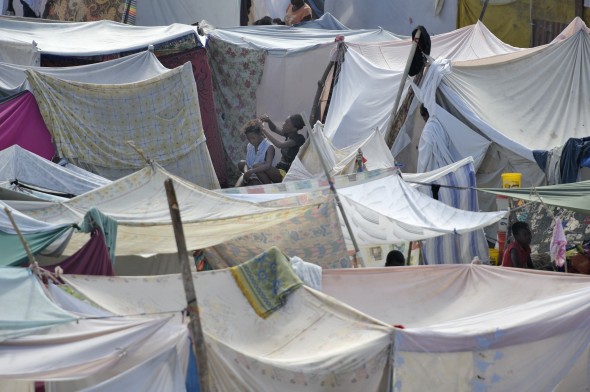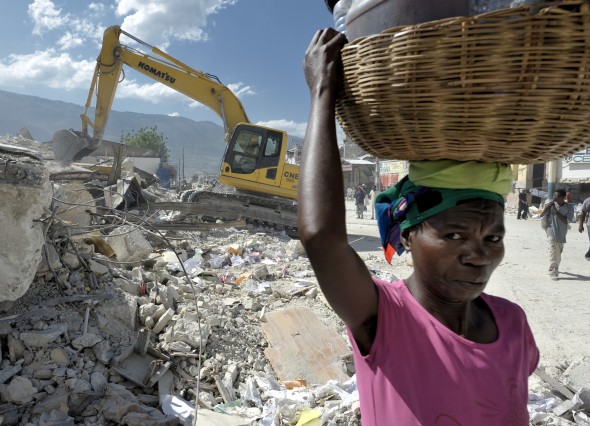Global Lens Reflections on life, the universe, and everything
Haiti: Six months later
Six months ago the earthquake hit Haiti, and things changed there forever. At this six month’s vantage point, some church relief groups are claiming all is well, so please keep the money and volunteers coming. But that’s a pretty rosy picture that isn’t backed up by facts on the ground.
Thomas Johnson, a humanitarian coordinator for DanChurchAid, a member of the ACT Alliance, wrote an editorial for the Los Angeles Times on June 25 called “Haitians still wait for recovery.” He lays out the case that “real recovery and reconstruction efforts have yet to begin, and there is a significant risk of further disaster.”
Johnson’s view, which is shared by many in the humanitarian community, albeit not always publicly, is a warning about the inability or unwillingness of the Haitian political elite to create an environment where true reconstruciton can begin. They’re champions at that. Some estimate that more than 10,000 NGOs worked in Haiti before the quake, all ostensibly working to educate, train and empower the Haitian poor. Yet not much changed. The culture proved flexible enough to absorb this largesse, paternalism, do-goodism–call it what you want–yet remained immune to real change that would threaten the power of the lighter-skinned elite. When true change came knocking with the movement headed by Father Jean Bertrand Aristide, it was brutally smashed by remnants of the Duvalier elite and their collaborators in the United States and other foreign capitals. Acting completely in historical character, the U.S. government–through the International Republican Institute–played a major role in encouraging and training the “rebels” that overthrew Aristide in 2004.
When you couple that historic pattern of corruption with the direct effects of the quake, it spells trouble. Some 1.5 million people are in “temporary” shelters but before a significant dent can be made in their plight, Haitians need to determine who owns what piece of land. That’s not an easy task after the quake killed some 16,000 civil servants and destroyed an untold number of title deeds and land registry records. Writes Imogen Wall, a public information officer of the United Nations Office for the Coordination of Humanitarian Affairs:
Over 3,700 transitional shelters have already been constructed and another 12,000 have arrived in country. The target is 125,000 by summer 2011, but the biggest obstacle to construction is a lack of clarity on land rights – most people had no written proof of land ownership even before the quake and many of those that did lost the papers in the disaster – and the need to remove rubble from sites before construction can start. Although thousands have now gone back to their homes and many have found other solutions – such as moving in with friends and relatives – the reality is that for some, living in camps will continue to be the only option for some time to come.
And even if you could figure out who owns what land in the capital, it’s likely to be covered with rubble. This disaster created an estimated 20 million cubic meters of debris and dealing with it will be a key challenge for some time to come. After six months, only 250,000 cubic meters has already been moved.
For a while the government proposed a massive plan to relocate hundreds of thousands of people to the countryside. It makes good sense on one level, given the unsustainable nature of the bloated capital. Yet the sustainability of life in the countryside is also a problem. Not long ago, Haiti produced more rice than it consumed. Then in 1995 the International Monetary Fund forced Haiti to reduce tariffs that protected its domestic rice industry. Foreign companies, mostly from the U.S., started dumping rice in Haiti. Most Haitian rice farmers went broke and migrated to the capital. Now that they’re supposed to move back to the countryside, how are they going to survive?
Yet any fair examination of the relief response should note what hasn’t happened. Sylvia Raulo, a Finnish colleague who has worked with the Lutheran World Federation in Haiti for years, says (in a Church World Service story by my friend Chris Herlinger) that the glass is half full: the achievements of the international humanitarian community in the first six months are the minimum of what could be hoped for, namely “the things we haven’t heard about. There were no political riots, there was no major food crisis, there was no major disease outbreak. . . It’s an achievement that we’ve managed to get the horror scenarios out of the picture.”
One of the best journalistic examinations I’ve found of the challenges of doing relief and development work in Haiti today can be heard on the May 21 episode of This American Life, entitled “Island Time.” It raises good questions about what we’re doing and not doing in Haiti to address deep-seated patterns of dependency that made Haiti the poster child for vulnerability before the quake. As we continue to accompany the Haitian people in responding to the quake, those questions should not be brushed aside because they threaten the brand image of any NGO.

